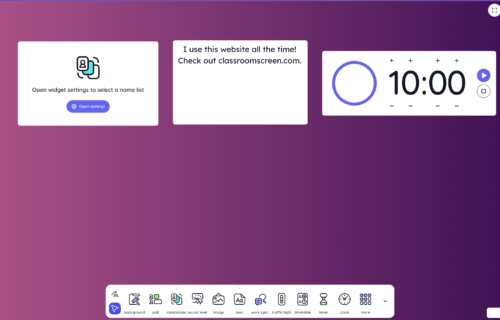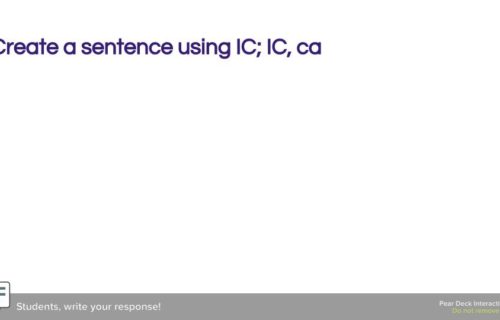
10 More Ways to Use Blogs in the Classroom and Beyond
For my class this week, we’re exploring blogging in the classroom.
All of us reviewed a great article, “33 Ways to Use Blogs in Your Classroom and an Educational Setting.” This post has great ideas for every grade level, but here are 10 more ways that you can use blogs in your classroom setting.
- I love using blogs for reaction journals/reading responses. I have always had my students write these when reading a novel, short story, or play, especially if they are writing a paper. I tell them to write what they think about the text; in other words, I want them to react to it. Did they hate it? Did they love it? Did a line stick out to them? I find that when they write about the text in this way, it helps them immensely when they have to write a literary paragraph or essay. I am a firm believer that students should write about topics that they are passionate about, so when the time comes for them to write, I have students look back at these reading responses to see what intrigued them during their initial reading of the text. Now, I know you can do all of that without a blog, but why is it beneficial to have students post this type of reading response/reaction on a blog? First, it means that their classmates can see what they are reading. This is beneficial for two reasons. They can get a reaction and comments from someone other than me, the teacher, but also I think that students produce a higher quality work when they know that others are reading it. It ups the ante, so to speak. Research shows that when students are blogging, they become better writers because their writing goes out to a larger audience. In “Blogging in the 21st Century Classroom”, Michelle Lampinen highlights many other advantages for blogging, so be sure to check her work out!
- I teach journalism, so blogs are also important for this class. Each issues, students are asked to write commentaries (personal opinion stories) and editorials (opinion pieces that represent the stance of the editorial board). Letting newspaper editors/students have blogs allows them to be more creative and lets their work reach a wider audience, as well. My classroom blogs are usually private, and only classmates can read them. Newspapers are open for a wider audience, and therefore, have potential to create a larger conversation and make a significant impact on the school community. SchoolJournalism.org offers some great tips for high school journalists to help them create successful blogs and even features some example student blogs.
- I love the idea of having students blog in “character”. Teachers can assign students characters to track during an entire work or just a chapter, and then the students can create a blog about that chapter or section from the perspective of that character. For example, in Romeo and Juliet, students can be assigned any number of main or minor characters. Think of the different perspectives that Mercutio, Benvolio, and Romeo would bring to their encounters. Even if characters are not in a scene or chapter, students can hypothesize what is going on and write a blog based on what they think may be going on in that character’s head. Mythology gods and goddesses also lend themselves easily to blogs, and students can interact with other gods and goddessess “in character”. Writing “in character” and interacting with their peers brings an entirely new level of understanding to both the text and the students’ understanding of the work and characters.
- Another use of blogs in the classroom is to let them be a forum for formative assessment of their reading comprehension, as well. I love Word Clouds like Tagxedo or Wordle. I think they make interesting, unique graphics to accompany blogs. Teachers of any content area can have students create word cloud after doing an assigned reading and then blog about why they chose the words they included in the word cloud. Before class, teachers can glance at student blogs and the word clouds to see if students understood the major concepts, and if they didn’t the teacher can review missed concepts.
- Blogs can also be used as an individual electronic portfolio for your students. Get rid of the file folders that are taking space in the corner of your classroom. Instead, let students document their growth, learning, and reflecting online. In “Using E-Portfolios in the Classroom”, Mary Beth Hertz shares a number of options for “e-portfolios”, but blogs can definitely be a contender for teachers to consider.
- As a future educational technology coordinator, a significant piece of my job will be teaching my faculty. The amount of technology that is evolving and that is at our disposal to use in our classroom can be intimidating, especially to teachers who aren’t (or who think they aren’t) tech savvy. That’s why I have this blog; it is a way for me to connect with teachers. I can provide tutorials, reviews, news, and advice on educational technology to help them be better at integrating it in their classrooms.
- In addition to blogging myself, it’s important for teachers to blog, as well. Throughout the year, my staff will be involved in independent professional development. They will be asked to brainstorm new ideas for tech integration in their classrooms, set goals for themselves, and reflect on the reading and exercises they are doing individually. An advantage of this for the entire faculty is they can learn from each other, and the staff can be accountable but do part of their professional development on their own time.
- The article “33 Ways to Use Blogs in Your Classroom and an Educational Setting” speaks very generally of how to use blogs with parents. I have seen some great teacher blogs that highlight what students do each week. Photos often accompany these blogs, and as the school year goes on, teachers have students write and reflect on their learning for the parents who are reading the class blog. I’ve seen teachers do this as young as the fourth grade level, and they’ve linked the blog to a class Facebook page so parents know when there is a blog to read. While I probably wouldn’t provide the link on a class Facebook page due to privacy reasons, I love the idea of keeping parents in the loop about learning and having the students take a role in sharing what they have learned and documenting it. The blog becomes a classroom portfolio instead of an individual portfolio.
- At Catholic schools, it’s important for specific departments and offices to blog. One department that should blog is the admissions office. This is often done at the college and university level, but for private high schools, the admissions office often houses the public relations department of the school. Highlighting student achievements and showcasing the school’s successes is important to attract prospective students and their parents.
- For similar reasons, the private schools’ development office should also blog. While the admissions’ office focus is incoming students, the development offices deal with alumni or alumnae. While alums probably want to see some of the achievements and successes that would be on the admissions blog, the development office has other public relations agendas. This blog could highlight information about faculty, other alums, jobs and careers, and, most importantly for development offices, ways that alums can give to the school—whether it is financially or with their time.
To read more on why I think teachers should use blogs, check out this post.




Add A Comment